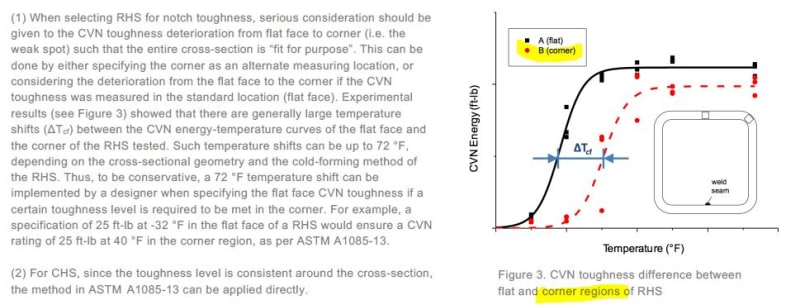-
1
- #1
Eng_Struct
Structural
Hi Group,
Point 1: I have a 10" x 10" x 5/8" HSS stub post for an equipment platform that has a crack running in the vertical direction along one of the corners. The post also has some bulging on the sides. The post is adequately designed for the loads. However, I am unclear what may have caused the crack. Even if the post was underdesigned, in my mind, none of the failure mechanisms (pure compression or flexural) will result in a vertical crack. Any thoughts if you think a load design failure can result in a vertical crack?
Point 2: The crack appears to be more similar to some of the other discussions on the forum related to water freezing inside the HSS. For the crack and bulging to occur, I would think that the post will need to be filled with water (note that the post is only 2' high). There are both top and bottom plates welded to the post and for the life of me I cannot figure out how could the water get inside. Any similar experiences or examples where water can still get inside the post and cause cracking?
Point 3: The post will need to be repaired. However, I want to analyze the current condition with crack and determine if there is still sufficient capacity. I am thinking of taking out a 1"x5/8" section at the cracked location and analyzing the remaining section as an "open" shape for combined bending and axial load. Any other ideas on analyzing HSS sections with vertical cracks for bending and axial.
Point 4: This ties back to point 3, for the bulging of the side walls, I am thinking I can check the effect of the walls locally considering the moment in the side wall plates caused by the eccentricity of the axial load. Any other thoughts?
Thanks
Point 1: I have a 10" x 10" x 5/8" HSS stub post for an equipment platform that has a crack running in the vertical direction along one of the corners. The post also has some bulging on the sides. The post is adequately designed for the loads. However, I am unclear what may have caused the crack. Even if the post was underdesigned, in my mind, none of the failure mechanisms (pure compression or flexural) will result in a vertical crack. Any thoughts if you think a load design failure can result in a vertical crack?
Point 2: The crack appears to be more similar to some of the other discussions on the forum related to water freezing inside the HSS. For the crack and bulging to occur, I would think that the post will need to be filled with water (note that the post is only 2' high). There are both top and bottom plates welded to the post and for the life of me I cannot figure out how could the water get inside. Any similar experiences or examples where water can still get inside the post and cause cracking?
Point 3: The post will need to be repaired. However, I want to analyze the current condition with crack and determine if there is still sufficient capacity. I am thinking of taking out a 1"x5/8" section at the cracked location and analyzing the remaining section as an "open" shape for combined bending and axial load. Any other ideas on analyzing HSS sections with vertical cracks for bending and axial.
Point 4: This ties back to point 3, for the bulging of the side walls, I am thinking I can check the effect of the walls locally considering the moment in the side wall plates caused by the eccentricity of the axial load. Any other thoughts?
Thanks

